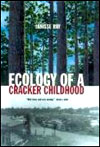“Beauty is so much in demand,” A. R. Ammons writes in his magnificent poem, “Garbage,” that “it’s a wonder natural / selection hasn’t thinned out anything not perfectly / beautiful.” Nature, he adds, “likes a broad spectrum approaching disorder so / as to maintain the potential of change with / variety and environment.”
No one has captured that disorder more beautifully than Janisse Ray. Ecology of a Cracker Childhood is Ray’s paean to the filth, rot, shit, and rust of her childhood on a Georgia junkyard. Half memoir, half polemic, Cracker Childhood is both a recollection of how Ray came to understand the natural world’s value and beauty, and an impassioned explanation of why the longleaf pine ecosystems of southeast Georgia, Alabama, and Florida must be defended against any further assault by humanity.
Ray’s prose is graceful and unhurried, yet to the point. As a child, she valued the natural world because it “wouldn’t ridicule you, would let you play.” Although that world was “oblivious…[going] about its business without you,” it was also “there when you needed some gift, a bit of beauty: it would be waiting for you. All you had to do was notice.”
If nature is oblivious to people, Ray’s family was oblivious to nature. Janisse Ray was born in rural southeast Georgia “from people who were born from people who were born from people who were born here.” Although she is unabashedly fond of her family and origins, Ray can be delightfully unsentimental: “My homeland is about as ugly as a place gets.”
Yet, “it wasn’t always this way,” and Ray knows who to blame: her ancestors and her neighbors — the “crackers” of the title who were too poor to care if their means of income (logging) was economically and environmentally unsustainable. From the 1840s to the 1930s, longleaf pine forests were decimated. Loggers slashed timber at an astonishing rate, destroying acres of longleaf pine and the ecosystem it supported. Of an original 85 million acres, less than 10,000 remain, most of which is now the playground of rich hunters.
Ray, however, is not consumed with regret for the forests that once were, or with anger toward her ancestors who helped slash it down. She recognizes the horror perpetrated on the world she loves by the people she loves, yet she keeps loving them both. “Not long ago,” she writes, “I dreamed of actually cradling a place, as if something so amorphous and vague as a region, existing mostly in imagination and idea, suddenly took form.” In Ecology of a Cracker Childhood, it does.



